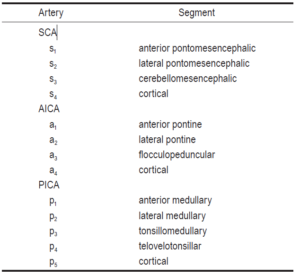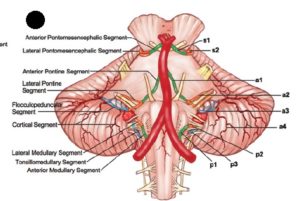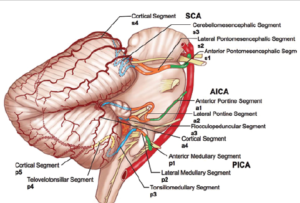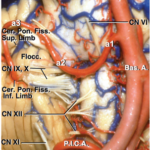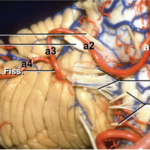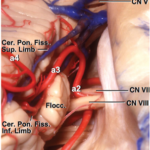Posterior Fossa Vascular Supply From Eye of Rhoton: Recapitulation (Part 2)
Anterior Inferior Cerebellar Artery (AICA)
The AICA originates from the basilar artery, usually as a single trunk, and encircles the pons near the abducent, facial, and vestibulocochlear nerves.
After coursing near and sending branches to the nerves entering the acoustic meatus and to the choroid plexus protruding from the foramen of Luschka, it passes around the flocculus on the middle cerebellar peduncle to supply the lips of the cerebellopontine fissure and the petrosal surface.
Anterior Pontine Segment, a1
This segment, located between the clivus and the belly of the pons, begins at the origin and ends at the level of a line drawn through the long axis of the inferior olive and extending upward on the pons.
This segment usually lies in contact with the rootlets of the abducent nerve.
Lateral Pontine Segment, a2
This segment begins at the anterolateral margin of the pons and passes through the cerebellopontine angle above, below, or between the facial and vestibulocochlear nerves and is intimately related to the internal auditory meatus, the lateral recess, and the choroid plexus protruding from the foramen of Luschka.
This segment gives rise to the nerve-related branches that course near or within the internal acoustic meatus in close relationship to the facial and vestibulocochlear nerves.
This segment is divided into portions:
- Premeatal
- Meatal
- postmeatal
This segment gives nerve-related branches and are the
Labyrinthine artery, which supplies the facial and vestibulocochlear nerves and vestibulocochlear labyrinth;
Recurrent perforating arteries, which pass toward the meatus but turn medially to supply the brainstem;
Subarcuate artery, which enters the subarcuate fossa. This segment not uncommonly dips below the pontomedullary junction, especially if it is tortuous.
Flocculopeduncular Segment, a3
This segment begins where the artery passes rostral or caudal to the flocculus to reach the middle cerebellar peduncle and the cerebellopontine fissure.
It commonly bifurcates near the facialvestibulocochlear nerve complex to form a rostral and a caudal trunk.
The rostral trunk sends its branches laterally along the middle cerebellar peduncle to the superior lip of the cerebellopontine fissure and the adjoining part of the petrosal surface.
The Caudal trunk supplies the inferior part of the petrosal surface, including a part of the flocculus and the choroid plexus.
The trunks that course along the peduncle may be hidden beneath the flocculus or the lips of the cerebellopontine fissure.
Cortical Segment, a4
Reference:
https://www.ncbi.nlm.nih.gov/pubmed/21548748

